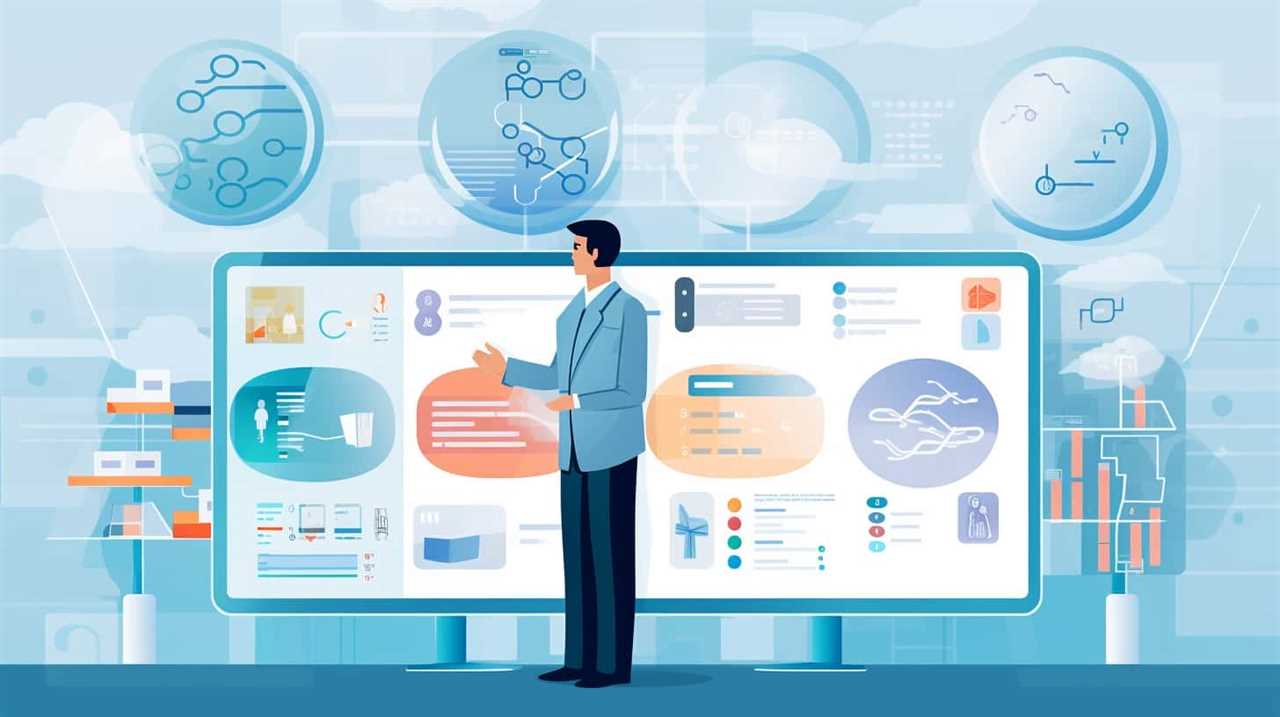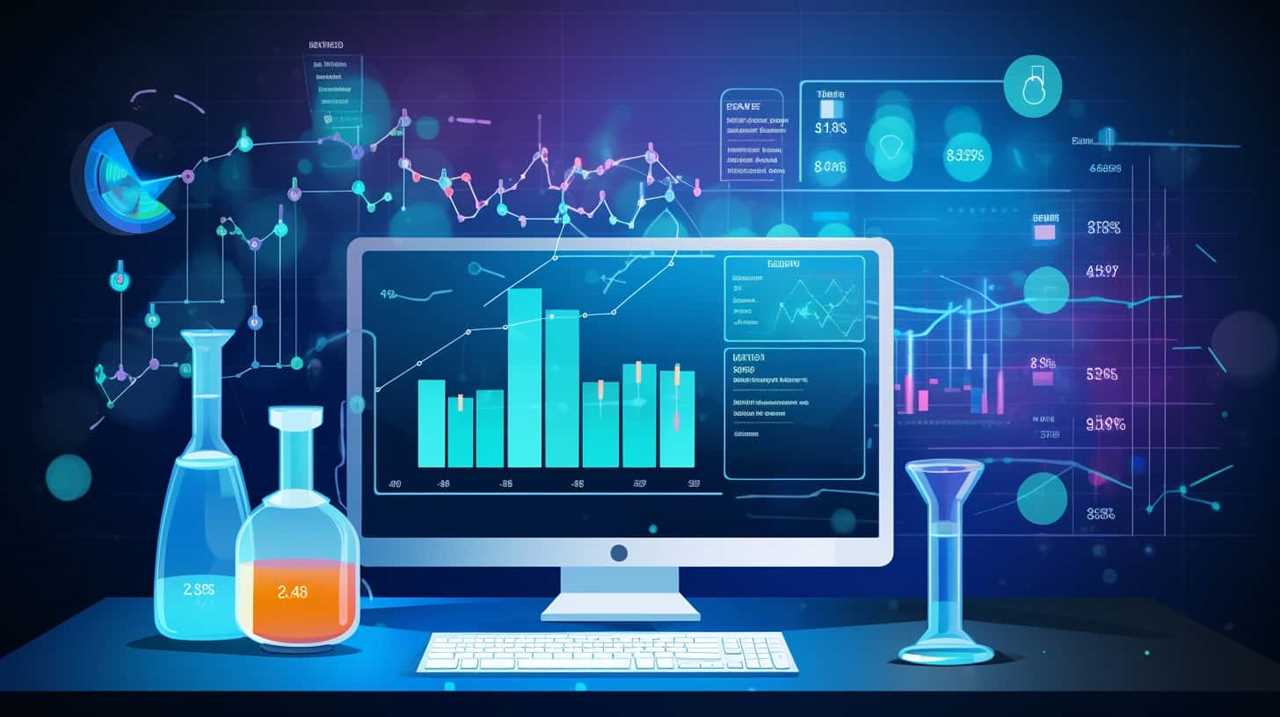Are you prepared to transform your business? Dive into the world of predictive analytics using machine learning.
With this powerful tool, we can unlock the true potential of your data, gaining insights that will propel your business to new heights.
By harnessing the power of machine learning, we can predict trends, customer behavior, and optimize operations like never before.
Say goodbye to guesswork and hello to data-driven success.
Get ready to transform your business with machine learning predictive analysis.
Key Takeaways
- Machine learning predictive analysis can drive growth and enhance decision-making capabilities in businesses.
- Predictive analysis helps identify patterns and trends in data, enabling organizations to make data-driven decisions.
- Implementing machine learning requires clear objectives, high-quality input data, selection and training of algorithms, and continuous evaluation and fine-tuning of models.
- Predictive analysis provides actionable insights that lead to improved business outcomes.

The Basics of Machine Learning
In this section, we’ll explore the fundamental principles of machine learning and how it can revolutionize our business. Machine learning is a subset of artificial intelligence that focuses on developing algorithms and models that enable computers to learn and make predictions based on data.
There are two main types of machine learning: supervised learning and unsupervised learning. Supervised learning involves training a model with labeled data, where the desired output is known. The model learns from this labeled data to make predictions on new, unseen data.
On the other hand, unsupervised learning involves training a model with unlabeled data, where the desired output is unknown. The model learns patterns and structures within the data to make sense of it.
Understanding the differences between supervised and unsupervised learning is crucial for implementing machine learning algorithms effectively. By harnessing the power of machine learning, we can uncover valuable insights, automate processes, and make data-driven decisions that will propel our business forward.

Understanding Predictive Analysis
To delve further into the topic of predictive analysis, let’s continue exploring how machine learning algorithms can enable us to forecast future outcomes and drive our business forward.
Predictive analysis involves using historical data to identify patterns and trends that can be used to make predictions about future events. This process relies on predictive modeling techniques and predictive analytics applications to analyze large datasets and extract valuable insights.
By leveraging advanced statistical algorithms and machine learning models, businesses can uncover hidden patterns in their data and make informed decisions. Predictive analysis empowers organizations to anticipate customer behavior, optimize operations, and mitigate risks.
It provides businesses with the ability to make accurate forecasts and proactive decisions, giving them a competitive edge in the market.
Now, let’s move on to explore how we can apply machine learning to our business strategies.

Applying Machine Learning to Business
By incorporating machine learning into our business strategies, we can harness its power to drive growth and enhance decision-making capabilities. Machine learning enables predictive modeling, which uses historical data to make predictions about future outcomes. This allows businesses to make informed decisions based on data-driven insights rather than relying solely on intuition or guesswork.
Predictive modeling involves the use of algorithms that analyze large amounts of data to identify patterns and relationships. These algorithms learn from the data and can make accurate predictions about future events or behaviors. By applying machine learning techniques to business, organizations can gain valuable insights into customer behavior, market trends, and operational efficiencies.
Data-driven decision making is a key aspect of applying machine learning to business. By leveraging the power of data and advanced analytics, businesses can make more informed decisions that are based on evidence rather than gut feelings. This approach can lead to improved efficiency, increased revenue, and better customer satisfaction.

Benefits of Predictive Analysis in Business
We can leverage predictive analysis in business to unlock a range of benefits. By applying predictive analysis techniques to our data, we can gain valuable insights that can greatly improve decision making within our organization.
Predictive analysis allows us to identify patterns and trends in our data, helping us make more informed and accurate decisions. It enables us to anticipate customer behavior and preferences, enhancing the overall customer experience.
With predictive analysis, we can identify potential risks and opportunities, enabling us to proactively respond and adapt to changing market conditions. This can result in increased efficiency, reduced costs, and improved business outcomes.

Implementing Machine Learning for Success
As we delve into the realm of implementing machine learning for success, harnessing the power of data-driven insights becomes paramount. To ensure successful implementation of machine learning applications, it’s crucial to follow a systematic approach.
First and foremost, organizations must identify the business problem or opportunity that can be addressed through predictive analysis. This involves defining clear objectives and determining the relevant data sources.
Next, data preparation and cleansing are essential to ensure the quality and reliability of the input data. Once the data is ready, the appropriate machine learning algorithms can be selected and trained using historical data.
It’s important to continuously evaluate and fine-tune the models to improve their accuracy and effectiveness.
Finally, the predictive analysis implementation should be integrated into existing business processes to drive actionable insights and enable informed decision-making.

Frequently Asked Questions
What Are the Limitations or Potential Drawbacks of Using Machine Learning Predictive Analysis in a Business Setting?
Limitations and potential drawbacks of machine learning predictive analysis in a business setting include the need for large and high-quality datasets, the risk of biased or inaccurate predictions, and the challenge of interpreting complex algorithms.
Are There Any Ethical Considerations or Concerns When Implementing Machine Learning Predictive Analysis in a Business?
When implementing machine learning predictive analysis in a business, there are ethical considerations and privacy concerns to address. We must ensure that data is used responsibly and that individuals’ privacy rights are respected throughout the process.
How Does the Quality and Quantity of Data Used for Training Impact the Accuracy of Predictive Analysis Models?
The accuracy of predictive analysis models is greatly impacted by the quality and quantity of data used for training. The more high-quality data we have, the more accurate and reliable our predictions become.
Can Machine Learning Predictive Analysis Be Used to Forecast Long-Term Trends or Is It More Suitable for Short-Term Predictions?
Machine learning predictive analysis can be used for both long-term forecasting and short-term predictions. It provides the ability to analyze historical data and identify patterns, allowing businesses to make informed decisions and anticipate future trends.
What Are Some Common Challenges or Obstacles That Businesses May Face When Implementing Machine Learning Predictive Analysis, and How Can They Be Overcome?
Implementing machine learning predictive analysis can be challenging due to data integration and quality management issues, resistance to change, and lack of expertise. These obstacles can be overcome through meticulous data cleansing, training programs, and strategic change management initiatives.

Conclusion
In conclusion, by harnessing the power of machine learning and predictive analysis, businesses can embark on a transformative journey. This cutting-edge technology allows companies to uncover hidden patterns, make data-driven decisions, and gain a competitive edge.
With predictive analysis at their disposal, businesses can confidently navigate the ever-evolving market landscape, optimize operations, and achieve unprecedented success.
Embrace the potential of machine learning and witness your business bloom and blossom with brilliance.









